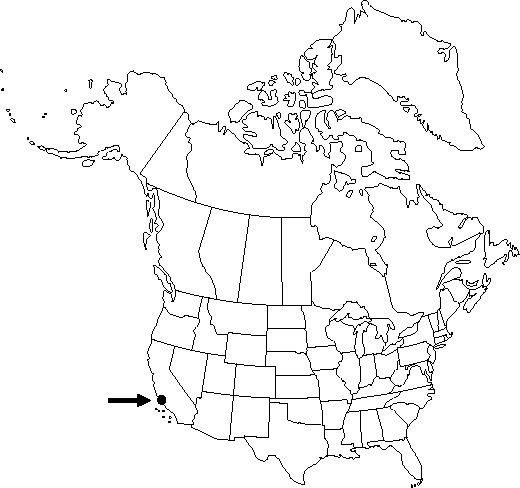Difference between revisions of "Delphinium parryi subsp. blochmaniae"
Brittonia 8: 19. 1954.
FNA>Volume Importer |
imported>Volume Importer |
||
| (7 intermediate revisions by 2 users not shown) | |||
| Line 16: | Line 16: | ||
}}{{Treatment/ID/Special_status | }}{{Treatment/ID/Special_status | ||
|code=F | |code=F | ||
| − | |label= | + | |label=Illustrated |
}} | }} | ||
| − | |basionyms={{Treatment/ID/ | + | |basionyms={{Treatment/ID/Basionym |
|name=Delphinium blochmaniae | |name=Delphinium blochmaniae | ||
|authority=Greene | |authority=Greene | ||
| + | |rank=species | ||
| + | |publication_title=Erythea | ||
| + | |publication_place=1: 247. 1893 (as blochmanae) | ||
}} | }} | ||
|synonyms= | |synonyms= | ||
| Line 30: | Line 33: | ||
}}<!-- | }}<!-- | ||
| − | --><span class="statement" id="st- | + | --><span class="statement" id="st-undefined" data-properties=""><b>Roots </b>less than 10 cm. <b>Stems</b> (19-)30-50(-65) cm. <b>Leaves</b>: basal leaves usually absent at anthesis; blade with ultimate lobes 7-25, width less than 3 mm. <b>Inflorescences</b>: bracteoles 7-10 mm. <b>Flowers</b>: sepals reflexed, lateral sepals 16-25 mm, spurs 11-16 mm; lower petal blades 7-10 mm, colored lighter than sepals (more so when dry). <b>2n</b> = 16.</span><!-- |
-->{{Treatment/Body | -->{{Treatment/Body | ||
| Line 38: | Line 41: | ||
|distribution=Calif. | |distribution=Calif. | ||
|discussion=<p>Of conservation concern.</p><!-- | |discussion=<p>Of conservation concern.</p><!-- | ||
| − | --><p>Delphinium parryi subsp. blochmaniae is very local; no other Delphinium is normally found within its limited range. It is easily recognized by its very large sepals and lower petals. The only species with which it might be confused is the large-flowered phase of D. variegatum; the latter has long hairs on proximal petioles vs. long hairs absent in D. parryi subsp. blochmaniae.</p> | + | --><p><i>Delphinium parryi </i>subsp.<i> blochmaniae</i> is very local; no other <i>Delphinium</i> is normally found within its limited range. It is easily recognized by its very large sepals and lower petals. The only species with which it might be confused is the large-flowered phase of <i>D. variegatum</i>; the latter has long hairs on proximal petioles vs. long hairs absent in <i>D. parryi </i>subsp.<i> blochmaniae</i>.</p> |
|tables= | |tables= | ||
|references= | |references= | ||
| Line 47: | Line 50: | ||
-->{{#Taxon: | -->{{#Taxon: | ||
name=Delphinium parryi subsp. blochmaniae | name=Delphinium parryi subsp. blochmaniae | ||
| − | |||
|authority=(Greene) H. F. Lewis & Epling | |authority=(Greene) H. F. Lewis & Epling | ||
|rank=subspecies | |rank=subspecies | ||
| Line 61: | Line 63: | ||
|publication title=Brittonia | |publication title=Brittonia | ||
|publication year=1954 | |publication year=1954 | ||
| − | |special status=Conservation concern;Endemic; | + | |special status=Conservation concern;Endemic;Illustrated |
| − | |source xml=https:// | + | |source xml=https://bitbucket.org/aafc-mbb/fna-data-curation/src/2e0870ddd59836b60bcf96646a41e87ea5a5943a/coarse_grained_fna_xml/V3/V3_1144.xml |
|genus=Delphinium | |genus=Delphinium | ||
|section=Delphinium sect. Diedropetala | |section=Delphinium sect. Diedropetala | ||
| Line 68: | Line 70: | ||
|species=Delphinium parryi | |species=Delphinium parryi | ||
|subspecies=Delphinium parryi subsp. blochmaniae | |subspecies=Delphinium parryi subsp. blochmaniae | ||
| − | |||
| − | |||
| − | |||
| − | |||
| − | |||
| − | |||
| − | |||
| − | |||
| − | |||
| − | |||
| − | |||
| − | |||
| − | |||
}}<!-- | }}<!-- | ||
-->[[Category:Treatment]][[Category:Delphinium parryi]] | -->[[Category:Treatment]][[Category:Delphinium parryi]] | ||
Latest revision as of 22:46, 5 November 2020
Roots less than 10 cm. Stems (19-)30-50(-65) cm. Leaves: basal leaves usually absent at anthesis; blade with ultimate lobes 7-25, width less than 3 mm. Inflorescences: bracteoles 7-10 mm. Flowers: sepals reflexed, lateral sepals 16-25 mm, spurs 11-16 mm; lower petal blades 7-10 mm, colored lighter than sepals (more so when dry). 2n = 16.
Phenology: Flowering early spring.
Habitat: Coastal chaparral, deep sand of dunes
Elevation: 0-200 m
Discussion
Of conservation concern.
Delphinium parryi subsp. blochmaniae is very local; no other Delphinium is normally found within its limited range. It is easily recognized by its very large sepals and lower petals. The only species with which it might be confused is the large-flowered phase of D. variegatum; the latter has long hairs on proximal petioles vs. long hairs absent in D. parryi subsp. blochmaniae.
Selected References
None.

